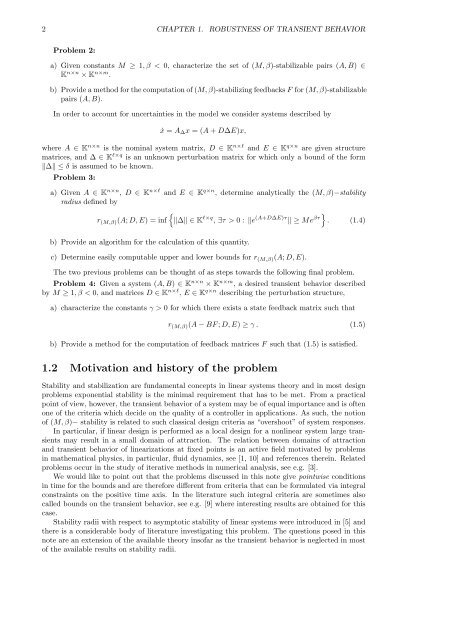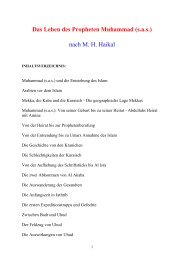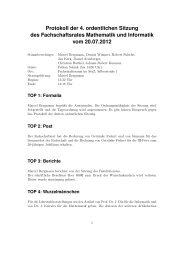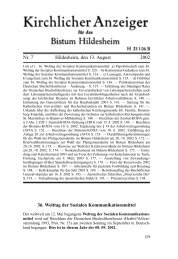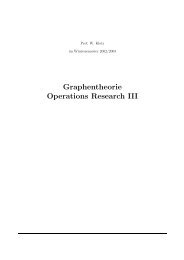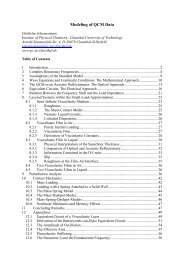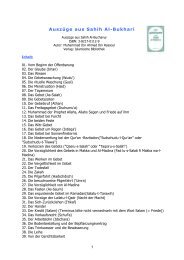Robustness of transient behavior - TU Clausthal
Robustness of transient behavior - TU Clausthal
Robustness of transient behavior - TU Clausthal
Create successful ePaper yourself
Turn your PDF publications into a flip-book with our unique Google optimized e-Paper software.
2 CHAPTER 1. ROBUSTNESS OF TRANSIENT BEHAVIOR<br />
Problem 2:<br />
a) Given constants M ≥ 1, β < 0, characterize the set <strong>of</strong> (M, β)-stabilizable pairs (A, B) ∈<br />
K n×n × K n×m .<br />
b) Provide a method for the computation <strong>of</strong> (M, β)-stabilizing feedbacks F for (M, β)-stabilizable<br />
pairs (A, B).<br />
In order to account for uncertainties in the model we consider systems described by<br />
˙x = A∆x = (A + D∆E)x,<br />
where A ∈ K n×n is the nominal system matrix, D ∈ K n×ℓ and E ∈ K q×n are given structure<br />
matrices, and ∆ ∈ K ℓ×q is an unknown perturbation matrix for which only a bound <strong>of</strong> the form<br />
�∆� ≤ δ is assumed to be known.<br />
Problem 3:<br />
a) Given A ∈ K n×n , D ∈ K n×ℓ and E ∈ K q×n , determine analytically the (M, β)−stability<br />
radius defined by<br />
r (M,β)(A; D, E) = inf<br />
b) Provide an algorithm for the calculation <strong>of</strong> this quantity.<br />
�<br />
�∆� ∈ K ℓ×q , ∃τ > 0 : �e (A+D∆E)τ �<br />
βτ<br />
� ≥ Me . (1.4)<br />
c) Determine easily computable upper and lower bounds for r (M,β)(A; D, E).<br />
The two previous problems can be thought <strong>of</strong> as steps towards the following final problem.<br />
Problem 4: Given a system (A, B) ∈ K n×n × K n×m , a desired <strong>transient</strong> <strong>behavior</strong> described<br />
by M ≥ 1, β < 0, and matrices D ∈ K n×ℓ , E ∈ K q×n describing the perturbation structure,<br />
a) characterize the constants γ > 0 for which there exists a state feedback matrix such that<br />
r (M,β)(A − BF ; D, E) ≥ γ . (1.5)<br />
b) Provide a method for the computation <strong>of</strong> feedback matrices F such that (1.5) is satisfied.<br />
1.2 Motivation and history <strong>of</strong> the problem<br />
Stability and stabilization are fundamental concepts in linear systems theory and in most design<br />
problems exponential stability is the minimal requirement that has to be met. From a practical<br />
point <strong>of</strong> view, however, the <strong>transient</strong> <strong>behavior</strong> <strong>of</strong> a system may be <strong>of</strong> equal importance and is <strong>of</strong>ten<br />
one <strong>of</strong> the criteria which decide on the quality <strong>of</strong> a controller in applications. As such, the notion<br />
<strong>of</strong> (M, β)− stability is related to such classical design criteria as “overshoot” <strong>of</strong> system responses.<br />
In particular, if linear design is performed as a local design for a nonlinear system large <strong>transient</strong>s<br />
may result in a small domain <strong>of</strong> attraction. The relation between domains <strong>of</strong> attraction<br />
and <strong>transient</strong> <strong>behavior</strong> <strong>of</strong> linearizations at fixed points is an active field motivated by problems<br />
in mathematical physics, in particular, fluid dynamics, see [1, 10] and references therein. Related<br />
problems occur in the study <strong>of</strong> iterative methods in numerical analysis, see e.g. [3].<br />
We would like to point out that the problems discussed in this note give pointwise conditions<br />
in time for the bounds and are therefore different from criteria that can be formulated via integral<br />
constraints on the positive time axis. In the literature such integral criteria are sometimes also<br />
called bounds on the <strong>transient</strong> <strong>behavior</strong>, see e.g. [9] where interesting results are obtained for this<br />
case.<br />
Stability radii with respect to asymptotic stability <strong>of</strong> linear systems were introduced in [5] and<br />
there is a considerable body <strong>of</strong> literature investigating this problem. The questions posed in this<br />
note are an extension <strong>of</strong> the available theory ins<strong>of</strong>ar as the <strong>transient</strong> <strong>behavior</strong> is neglected in most<br />
<strong>of</strong> the available results on stability radii.


